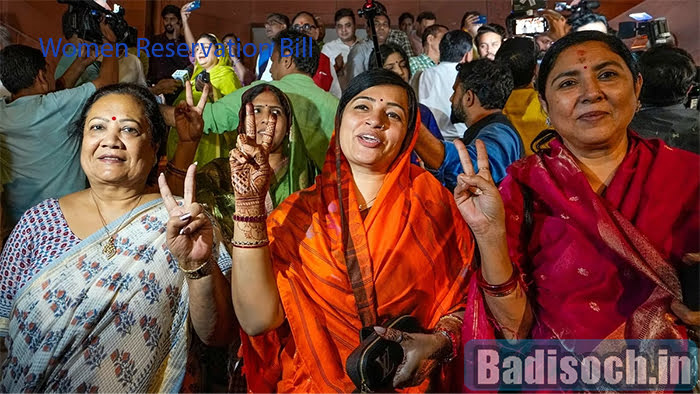Women Reservation Bill : The Constitution 108th Women Reservation Bill, 2008 stipulates that women should be given one-third (33%) of the seats in state legislative assemblies and Parliament. The law also recommends sub-reservation for SCs, STs, and Anglo-Indians within the 33% quota. Several state or union territory constituencies have the option of rotationally allocating reserve seats. As per the approve law. The seats designate for women will be eliminate 15 years from the amendment act’s start date.
This reservation system is aim at promoting gender equality and empowering women to participate in politics. Ultimately leading to better governance and decision-making. However, despite its implementation being a step in the right direction, it remains a contentious issue in Indian politics with some questioning its effectiveness in achieving its intend goals.
Women Reservation Bill
According to sources, there is an urging for several BJP ministers and MPs to encourage female voters to participate in the upcoming parliamentary elections. On Monday, BJP President JP Nadda held a meeting with several of them. Many individuals have been pushing for the implementation of the Women Reservation Bill, which aims to provide a 33% quota for women in both the Lok Sabha and state legislatures. The Congress Working Committee also address this matter and adopt a resolution during their meeting in Hyderabad on Sunday.
The Women’s Reservation Bill, which aims to reserve one-third of seats in the Lok Sabha and state legislative assemblies for women, has been a long-standing issue in Indian politics. The bill was first introduce in Parliament in September 1996 by the H.D. Deve Gowda-led administration. Despite several attempts by subsequent governments to pass the bill, including successful passage through the Rajya Sabha in 2010 by the UPA administration, it has yet to be implement due to political disagreements and a lack of determination. The journey of this bill highlights the ongoing struggle for gender equality and representation in Indian politics.
Women Reservation Bill Details
| Article Name | Women Reservation Bill |
| Category | News |
 |
|
| Telegram | |
| Official Website | Click Here |
Also Check: School Assembly News Headlines Today 2023
Key Issues and Analysis of the Women’s Reservation Bill
- The reservation policy is a subject of debate. Advocates argue that affirmative action is necessary to support women. Recent research on panchayats indicates that reservation is beneficial in empowering women and distributing resources.
- Critics argue that this approach would exacerbate the problem of gender inequality as it would prevent women from competing bas on their abilities. They contend that focusing on this strategy diverts attention from more pressing issues in election reform, such as the criminalization of politics and the lack of inner-party democracy.
- The limitation of voter choice to women is a result of reserving seats in Parliament. As a solution, some analysts propose the implementation of political party reservation and the introduction of dual-member seats.
- The rotation of reserve seats in every election has the potential to diminish the motivation of MPs to work for their constituencies, as they may not be re-elect.
- Following the amendment of the Constitution to allow for the OBC quota, the 1996 Women’s Reservation Bill report propose the reservation of seats for OBC women. Additionally, there were suggestions to implement reservation in the Rajya Sabha and Legislative Councils. However, neither of these suggestions were include in the final version of the Bill.
Check Here: Why Yadavs are agitating for an Ahir regiment in Indian Army Explained 2023
What is the way forward?
- India possesses a significant number of women, who serve as a substantial source of untapp potential that. If harness, could propel the country towards progress.
- By including women, democracy will be jump-start as it allows the majority of individuals to have a say in determining how their lives should be governed.
Why is the Bill hard to pass?
The Women’s Reservation Bill. Which aims to reserve seats for women in the Rajya Sabha, faces a significant hurdle due to the current electoral system. The single transferable vote technique used in this system allocates votes to preferred candidates, making it difficult to reserve specific seats for underrepresented groups such as women. This challenge underscores the need for electoral reforms that support gender parity and ensure fair representation of all sections of society in political decision-making processes. Such reforms could include measures such as reserved constituencies or proportional representation systems that better reflect the diversity of India’s population.
Currently, there are no reserved seats in the Rajya Sabha for Scheduled Castes (SC) and Scheduled Tribes (ST). If there is a desire to introduce such reservations, it would require a constitutional amendment to change the voting process. The Rajya Sabha is the upper house of India’s bicameral parliamentary system, and its members are elected by state legislatures. The Indian Constitution provides for reservation of seats for SCs and STs in Lok Sabha, the lower house, but not in Rajya Sabha.
Look Here: Chandrayaan-3 Moon Landing Today Live Updates
Why is WRB important?
Throughout history, women have been adversely affected by societal limitations and prejudice.
- Caste groups – It is essential for any proposal regarding women’s reservation to abide by constitutional principles and also take into account the diversity of caste.
- Gender quota – Our democracy would suffer greatly if there was no gender quota, leading to minimal representation for women.
- Panchayats – New studies on panchayats have indicated that the implementation of reservation has a positive effect on resource allocation and the empowerment of women.
- Vote share – Although there has been a rise in the proportion of women participating in voting. There is still insufficient representation of women in positions of power.
Read More: G20 Summit New Delhi 2023
What is the status of Women’s Reservations in India?
- Gujarat – Only 8% of the candidates in the 182-member parliament were women.
- Himachal Pradesh – In a voting population where women constitute 50% of the voters, only one woman has been elected, while 67 males have secured positions.
- National average – Currently, the representation of women in state legislatures across the country remains at a mere 8%.
- Rankings – India has been ranked 144th out of 193 nations in terms of women’s representation in parliament. As per a survey conducted by the Inter-Parliamentary Union.
Why did the parliament fail to pass the WRB?
- Heated debates & sexist taunts – The WRB has witness several controversial discussions and a significant amount of misogyny.
- Quota within quota – The committee in 1996 proposed that OBC women should have a quota within the one-third reservation for women in the Bill. Unfortunately, this suggestion was never put into action.
Opponents claim that the WRB will not help their ladies as a result of this.
- Lack of political ability – Seats reserve for female candidates in elections are only available in the Biju Janata Dal (BJD) of Odisha and the Trinamool Congress (TMC) of West Bengal.
- Diverts attention – Critics of WRB argue that it diverts focus from crucial electoral reform issues such as the criminalization of politics and party democracy.
Conclusion
The Women Reservation Bill is a proposed legislation in India that seeks to reserve 33% of seats in parliament and state legislative assemblies for women. The bill aims to address the underrepresentation of women in politics and empower them to actively participate in decision-making processes. Proponents argue that such a reservation will lead to more inclusive and diverse governance, as well as better policies that reflect the needs and concerns of women. However, the bill has faced opposition from various quarters, with critics expressing concerns about its implementation and potential impact on other marginalized communities.
Women Reservation Bill FAQ’S
When was the first women reservation bill?
A lengthy and intense debate arose during a 10-minute discussion on the Bill on 12 September 1996. Certain male MPs questioned whether reservation could attract sufficiently capable women. However, other MPs criticized the bill for its exclusion of reserved seats for women from backward caste communities.
What is the objective of the women reservation bill?
The objective of the Constitution (One Hundred and Eighth Amendment) Bill, 2008 is to set aside one-third of the total seats in the Lok Sabha and state legislative assemblies for women. The authority designated by Parliament will be responsible for determining the allocation of these reserved seats.
What is the women's reservation Bill Class 8?
The Lok Sabha and the legislative assemblies were to have 33% reservation for women according to the bill. However, after being referred to a Joint Parliamentary Committee, the bill expired when the Lok Sabha was dissolved. The bill was reintroduced in 1998 during the 12th Lok Sabha.
Which caste has highest reservation in India?
In central-government funded higher education institutions, 22.5% of available seats are reserved for Scheduled Caste (SC) and Scheduled Tribe (ST) students (7.5% for STs, 15% for SCs,20% for ESC,12% for SCA,16% for SCB,22% for SCC,18% for SCD).
Related Post:
